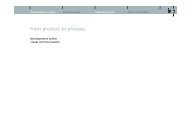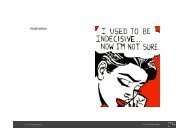Read the trend - Michael B. Hardt | Designer
Read the trend - Michael B. Hardt | Designer
Read the trend - Michael B. Hardt | Designer
- No tags were found...
Create successful ePaper yourself
Turn your PDF publications into a flip-book with our unique Google optimized e-Paper software.
Prof. <strong>Michael</strong> <strong>Hardt</strong>All successful inventions in <strong>the</strong> late past have got something to do with time.Example:Train, car, plane.Telephone, radio, TV, InternetPsychology informs us that:People want to have everything: now, individual and convenient.Every invention, which is fast, individual and convenient, will be successful.Every invention, which is slow, mass-oriented and inconvenient, will disappear.Let me give you two examples of future developments following this rule, whichwill be of high relevance for <strong>the</strong> visual communication designer, a question ofsurviving in this profession:Example No. 1The future of printed media“Who want yesterdays papers” sang <strong>the</strong> Rolling Stones in 1965. The idea of anewspaper was to inform <strong>the</strong> public in <strong>the</strong> shortest possible time. But today we havenew media like TV and Internet, which are much faster. When a newspaper reaches <strong>the</strong>reader, <strong>the</strong> content is already old. Today we want news equal to time. Newspapershave no longer <strong>the</strong> advantage to be actual. They are not individual ei<strong>the</strong>r. When I buy anewspaper I am not interested in <strong>the</strong> stock exchange news or sports or <strong>the</strong> huge stupidads telling me what I have to buy if I want to be a good man.They are not very convenient ei<strong>the</strong>r. I am often sitting in planes and <strong>the</strong> fightwith <strong>the</strong> newspaper and my neighbor’s newspaper could be <strong>the</strong> content of a funnyfilm.But:2
Prof. <strong>Michael</strong> <strong>Hardt</strong>We like newspapers.They are an important part of our culture.And I can read everywhere.Somebody said quite rightly: You don’t take your laptop with you when you goon <strong>the</strong> toilet. You could also add that <strong>the</strong> laptop has no additional cleaning value.But: There is a new generation coming up which has been born in <strong>the</strong> computerage. They are not used to newspapers; <strong>the</strong>y are not willing to get used to <strong>the</strong>m.Newspapers are not part of <strong>the</strong>ir culture.enough.They take <strong>the</strong>ir Nintendo to <strong>the</strong> toilet and consider newspapers not to be softThe newspapers as we know <strong>the</strong>m today will most probably die because offinancial reasons. The number of readers will become so unimportant that <strong>the</strong>advertisement income will disappear.This development has started and become visible for example in Germany. Itstarted seemingly unexpected but <strong>the</strong> warning signs have been visible for a long time.Nobody wanted to be aware of it. But this does not mean that we will only read frommonitors in <strong>the</strong> future.It is interesting to see <strong>the</strong> development of <strong>the</strong> books. There are different types ofbooks that will see a different development in <strong>the</strong> future. While specialised books arestruggling, belletristic is increasing.Specialised books areInconvenientThe buying process and <strong>the</strong> storage is complicated and time-consumingSlowIt takes a lot of time to find <strong>the</strong> relevant informationNot individualA lot of <strong>the</strong> content is not relevant3
Prof. <strong>Michael</strong> <strong>Hardt</strong>Belletristic literature is convenient, you can read it everywhere, time does notmatter; in fact <strong>the</strong> time you spend with a book is pleasant and it is individual.What about <strong>the</strong> future of printing as such?The new media is about to replace a lot of printed matters of <strong>the</strong> past.New media are often much better in fulfilling <strong>the</strong> task of former printed matters.Again <strong>the</strong>y are faster, more convenient and more individual. New printing systemsand methods to increase speed, convenience and individuality have been developedand on <strong>the</strong>ir way to be used.Computer to plate30 years ago a colour separation took up to 2 weeks, today you can do <strong>the</strong> samewithin 4 minutes.In <strong>the</strong> 60ies of <strong>the</strong> last century, offset was winning <strong>the</strong> race against letterpressprinting. The plate processing was <strong>the</strong> winning factor because it was faster thanletterpress preprint.Trying to make things even faster, <strong>the</strong> idea came up to develop software to godirectly from <strong>the</strong> DTP to <strong>the</strong> plate. This meant <strong>the</strong> death of two very old professions:The typographer or typesetter and <strong>the</strong> lithographer.We have to understand <strong>the</strong> historical context: Gutenberg’s invention of <strong>the</strong>letterpress has changed <strong>the</strong> society and lasted for 520 years. Within less than one yearthis technology was wiped away. A revolution is taking place that might have <strong>the</strong>same impact on <strong>the</strong> society like Gutenberg’s movable letters.If big changes are happening, how can we continue to think small?4
Prof. <strong>Michael</strong> <strong>Hardt</strong>Computer to printThe idea is simple and you will find out not even very new: Increase <strong>the</strong> speed ofpreprint and individualize <strong>the</strong> print. Again <strong>the</strong> rule counts: Speed, individuality andconvenience.Everybody today is working on increasing <strong>the</strong> speed concept to market. To giveyou an idea what I talk about: Today <strong>the</strong> developing time for a new product in food isabout 1.5 years. We are working in my studio on a design management project toincrease <strong>the</strong> speed from 1.5 years to 24 hours. From <strong>the</strong> idea to <strong>the</strong> consumer!Computer to print is nothing but <strong>the</strong> laser printer we have today. The printcylinder will be loaded electro-magnetically and <strong>the</strong> activated parts take on a pigmentpowder that will be laid on <strong>the</strong> paper and fixed through heat. With every turn of <strong>the</strong>cylinder this loading must be renewed. This gives <strong>the</strong> advantage that with every turnof <strong>the</strong> cylinder; a new picture can be printed. There are still technical problems to besolved like light stability and calibration. There is also a cost problem. Issues of up to5.000 prints in digital printing are cheaper than in offset, in big issues offset is stillcheaper. The engineers are working on this and <strong>the</strong>y will find solutions soon.But ano<strong>the</strong>r effect will kill <strong>the</strong> classical printing:Today we have huge printing factories. From <strong>the</strong>re <strong>the</strong> printed material istransported to <strong>the</strong> customer and from <strong>the</strong>re to <strong>the</strong> single user. The transportation istime, energy and cost consuming. The whole concept is slow, inconvenient and notindividual.5
Prof. <strong>Michael</strong> <strong>Hardt</strong>The printing industry has built up over-capacities in <strong>the</strong> past. Giant machines aretoday fed with small projects just to keep <strong>the</strong>m running. There is hardly money to earnand many printers go bankrupt: Too big capacities and too much competition for adecreasing amount of work.Printing will be decentralized.The new technology makes it possible to have smaller printing units closer to <strong>the</strong>user. The final consequence could be <strong>the</strong> printing machine at <strong>the</strong> desk of <strong>the</strong> user. Andthis is not future, this happens every day: You find something interesting on <strong>the</strong> webbut you don’t want to read it on <strong>the</strong> monitor. So you print <strong>the</strong> relevant information onyour own laser printer.But this has influence on our profession. We have to change our way of thinking.Let me give you an impression of <strong>the</strong> development:In my studio we have been specialists for printed media since nearly 30 years.We designed catalogues, brochures, stationary, leaflets etc. This made 80% of ourincome. Today, it is less than 5%. But new fields of activity came up that turned out tobe much more interesting and filled this gap. We are earning our income today inconceptual and strategic design consulting. We have doubled our turnover while manycolleagues earn far less than before or even went bankrupt.<strong>Designer</strong>s have to understand that <strong>the</strong> communication process is more importantthan <strong>the</strong> communication product.6
Prof. <strong>Michael</strong> <strong>Hardt</strong>Example No. 2The future of <strong>the</strong> supermarketThe supermarkets we know today have come from America to Europe not earlieras <strong>the</strong> 60ies of <strong>the</strong> last century. So <strong>the</strong>y are something like 40 years old. In an incrediblespeed <strong>the</strong>y changed consumer behaviour and led to <strong>the</strong> economical end of manyshopkeepers. The process was cruel.As a consequence <strong>the</strong> density of food distribution became reduced. Where youfound many little shops in <strong>the</strong> neighbourhood you now see huge markets mainly in <strong>the</strong>outskirts of cities.This has also brought problems for <strong>the</strong> old or handicapped people or peoplewithout cars.Supermarkets are not only a visual pollution. Huge parking space is necessarydue to <strong>the</strong>ir position at <strong>the</strong> outskirts and not in <strong>the</strong> centre. It means a huge waste of realestate. All customers have to use a lot of <strong>the</strong>ir time to go <strong>the</strong>re. The amount of petrolthat is used for <strong>the</strong> food supply is a total waste of energy resources.So Supermarkets are not convenient, not individual and not fast.And so <strong>the</strong>y will die in a short time.In <strong>the</strong> nineties, tests with new, convenient, individual and fast supply systems,using new media, took place in <strong>the</strong> USA and in Europe.But <strong>the</strong>y all flopped.The right idea, presented in a wrong way to <strong>the</strong> wrong target group at <strong>the</strong> wrongtime is not a bad idea, but a bad execution. The concept will be standard in less than 10years and today’s supermarkets will disappear in latest 20 years.7
Prof. <strong>Michael</strong> <strong>Hardt</strong>Tomorrow I will organize my food supply with <strong>the</strong> help of my computer. He willtell me what I have to buy, make proposals for <strong>the</strong> cooking and tell me exactly howmuch I will have to pay and how much money is left on my account. He knows me. Ican accept <strong>the</strong> proposals or change <strong>the</strong>m. When I click enter, <strong>the</strong> bill is paid and at <strong>the</strong>same time a caddy starts to make his way through <strong>the</strong> storage hall. Arriving at <strong>the</strong>ramp <strong>the</strong> caddy will be loaded in a little delivery car, driven with electricity or water,will start. At a convenient time someone will ring my doorbell and hand out <strong>the</strong> goods.Do I read this in a crystal ball?How do I know that this will happen? If I tell you that one and one makes two, Iam not a magic fortune-teller, I am just logic.a. Supermarket shopping is no fun. Fun shopping is something else.b. Technically <strong>the</strong>se distribution systems exist and are standard in b to b.c. With an increasing number of Internet users and <strong>the</strong> normality to usethis medium, <strong>the</strong> critical margin of potential users will become crossed.Comparing <strong>the</strong> existing supermarket with <strong>the</strong> new system shows that <strong>the</strong> newsystem will be more convenient, faster and more individual and thus winning.There are also consequences for <strong>the</strong> visual communication designers involved:Today, food-packaging design is concentrating on <strong>the</strong> highest possible shelfimpact. The product has to stand out from <strong>the</strong> shelf and beat <strong>the</strong> competing products at<strong>the</strong> PoS, <strong>the</strong> point of sale.But as <strong>the</strong>re will be no shelf tomorrow, you don’t need shelf impact.But it has to make a good impression at <strong>the</strong> PoU, <strong>the</strong> point of Use.And yes: much information will no longer print on <strong>the</strong> packaging. RadioFrequency Identification (RFID) will replace <strong>the</strong> barcode on products. Electronic chipslike on banking cards will contain information and new functions.8
Prof. <strong>Michael</strong> <strong>Hardt</strong>It is <strong>the</strong> task of <strong>the</strong> communication designer to make <strong>the</strong>se new functionsavailable. These functions help to individualise mass products. The concept is that youget your personal milk-box, with your name on it and individualised information: Forexample allergic warnings etc.This individualisation combines new distribution systems with new printingtechnologies.Again: We just have open eyes and can add one plus one.As designers we have to have <strong>the</strong>se open eyes, travel a lot, go to conferences andread a lot of specialised information. We have to learn how to read <strong>trend</strong>s, see <strong>the</strong>chances and risks that come out of social, economical and technological developmentsand work from <strong>the</strong> future to <strong>the</strong> presence, not from <strong>the</strong> presence to <strong>the</strong> future. We haveto design today what will be tomorrow today’s design.If we design today’s fashion and Zeitgeist and <strong>the</strong> design will be publishedtomorrow we are designing today yesterdays design. If we only decorate products wedon’t understand <strong>the</strong> power of designing process.A designer needs <strong>the</strong> skills and <strong>the</strong> talent to see into <strong>the</strong> future, and make adesign for a precisely defined time in <strong>the</strong> future.<strong>Read</strong>ing <strong>the</strong> future includes <strong>the</strong> risk of error. But if you see <strong>the</strong> specialists infuture reading you will be astonished how precise <strong>the</strong>y are. It is a little bit like <strong>the</strong>wea<strong>the</strong>r forecast. You can be pretty sure that it is correct. And in <strong>the</strong> few cases when<strong>the</strong>y have an error you can be sure that it is raining instead of sun, not <strong>the</strong> o<strong>the</strong>r wayround.Prof. <strong>Michael</strong> <strong>Hardt</strong>Opening lecture of <strong>the</strong> study year 2003-04 at <strong>the</strong>Bergen National Academy of <strong>the</strong> Arts, August 20039








